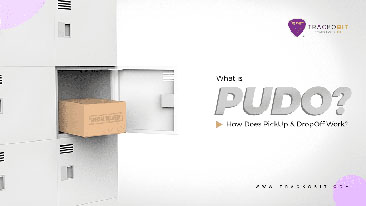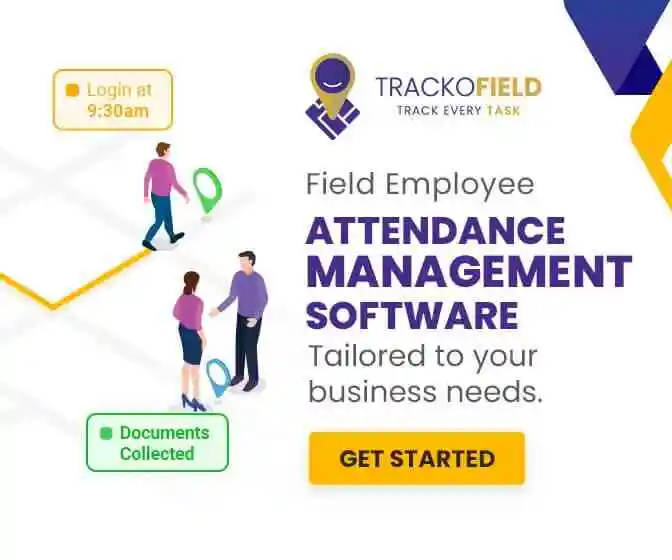-
TrackoBit
Manage commercial vehicles with the new-age Fleet Management Software
TrackoBit -
TrackoField
Streamline your scattered workforce with Field Force Management Software
TrackoField -
Features Resources
-
Blog
Carefully curated articles to update you on industrial trends. -
White Paper
Insightful papers and analysis on essential subject matters. -
Glossary
Explore an alphabetical list of relevant industry terms. -
What’s New
Get TrackoBit & TrackoField monthly updates here. -
Case Study
Explore the cases we solved with our diverse solutions. -
Comparisons
Compare platforms, features, and pricing to find your best fit.
-
About Us
Get to know TrackoBit: our team, ethos, values, and vision. -
Careers
Join the most dynamic cult of coders, creatives and changemakers. -
Tech Support
Learn about our technical support team and services in detail. -
Events
Check out the exhibitions where we left our marks and conquered. -
Contact Us
Connect with us and let us know how we can be of service.
Implementing Real-time Tracking For Fleet Management
- Author:Tithi Agarwal
- Read Time:6 min
- Published:
- Last Update: March 3, 2025
Table of Contents
ToggleLooking for ways to improve and optimise your fleet management? Then real time tracking is the perfect solution.
Table of Contents
Toggle
Real-time tracking for fleet management is a necessity for fleet dependent businesses. With the help of real time tracking, managers are able to –
- Track real-time location of the vehicles
- Monitor fuel usage
- Track engine hours
- Schedule vehicle maintenance
Fleet management software with real time tracking brings the data businesses need to carry trips. They are getting visibility into every aspect of the operations.
In this article, we have discussed what real time tracking is. Also, learn how beneficial it is for enhanced fleet management.
Fleet Management: Overview?
Fleet management comprises of monitoring and managing vehicles. This is done by keeping a close eye on driver behaviour through tracking. Transportation businesses need to manage their trips in a lucrative manner. This will help with –
- Increasing vehicle productivity
- Ensuring the safety of the drivers and vehicles
- Reduce operational expenses
- And ensure compliance with road rules and regulations.
What is Real-time Fleet Tracking?
Real-time fleet tracking allows businesses to locate and monitor their remote vehicles. The system utilises technology such as GPS and telecommunications. Vehicles are installed with GPS trackers. The devices communicate with the satellites to determine the exact geographical location.
However, the data received is raw and needs to be processed to be segregated into multiple use cases. This is done by fleet management software like TrackoBit.
Fleet Management Software: A Gist
Fleet management software, with real time tracking data, is a powerful tool. With the software, managers can organise, supervise and coordinate their fleets in real-time. It provides them with all the processed and analysed data. Additionally, it gives organisations a complete picture of their activities.
The software monitors data for
- vehicle diagnostics,
- driving behaviours,
- maintenance requirements,
- fuel consumption, and more.
It does so by connecting to sensors, GPS trackers, and telematics devices. These sensors and GPS hardware are integrated into vehicles. This allows hardware-free seamless communication via the software.
4 Ways To Implement Real-time Fleet Tracking
Here are the most common and efficient ways to implement real time fleet tracking.
1. GPS Tracking Devices
Every fleet can use GPS tracking devices because they have both been around long enough. Every vehicle’s GPS location can be transmitted by wireless transmission, typically over a cellular network. If connected properly, the vehicles’ own electricity will power GPS devices, which can then transmit the data to depict each vehicle’s location.
2. OBS Plug-In Devices
You can broadcast more than just the fleet’s location. OBS GPS devices connect to a port often located underneath the steering wheel. This reads data from vehicles. An OBS plug-in device can access data such as speed, velocity, brake pedal use, torque, and warning lights. Fleet managers can read real-time data on each fleet vehicle from fleet management software that device transmitters.
The OBS data is crucial because it can indicate whether a vehicle requires repairs, is in trouble, or is operating strangely. OBS gives location data depth and context.
3. GPS and Communication through to Driver Cellphones
Connecting via driver smartphones is the easiest way to use live tracking. Most people have access to or can obtain a cell phone; even feature phones work just fine. An app that offers GPS tracking and real-time communication can be run through that. Messages can also be sent or the driver’s app.
4. Streaming Dash Cams
Dash-cams are cameras mounted all around the vehicle to record its position, surroundings, and movement, and are the final fleet-tracking technique. When people are on board, an inward-facing dash cam serves as a security camera, which may be crucial.
A feed and a record of traffic conditions and the specifics of any possible incidents are produced by outward-facing cameras. These cameras are AI enabled which further enhances the security level.
What are the Benefits of Tracking a Fleet in Real Time?
a) Decreased Vehicle Theft
Companies lose an average of $30 billion from vehicle Thefts. To prevent such thefts, knowing their real time location can tremendously help. Efficient fleet management software allows you to set geofences, monitor fleet location and activities, and send out alerts in case of anomalies. This helps to ensure that the drivers are sticking to the assigned routes.
Softwares like TrackoBit have a route replay feature, which helps to identify lengthy and unauthorised stops.
b) Improved Route Planning
Fleet management combined with GPS real-time tracking provides updates on traffic conditions, road conditions, and many other factors. This helps in assigning routes to vehicles and adapt to changes easily.
Another benefit of the software is that it provides trip history data accessible for 6 months. Analysis of trip history can reveal patterns and help in improving fleet performance.
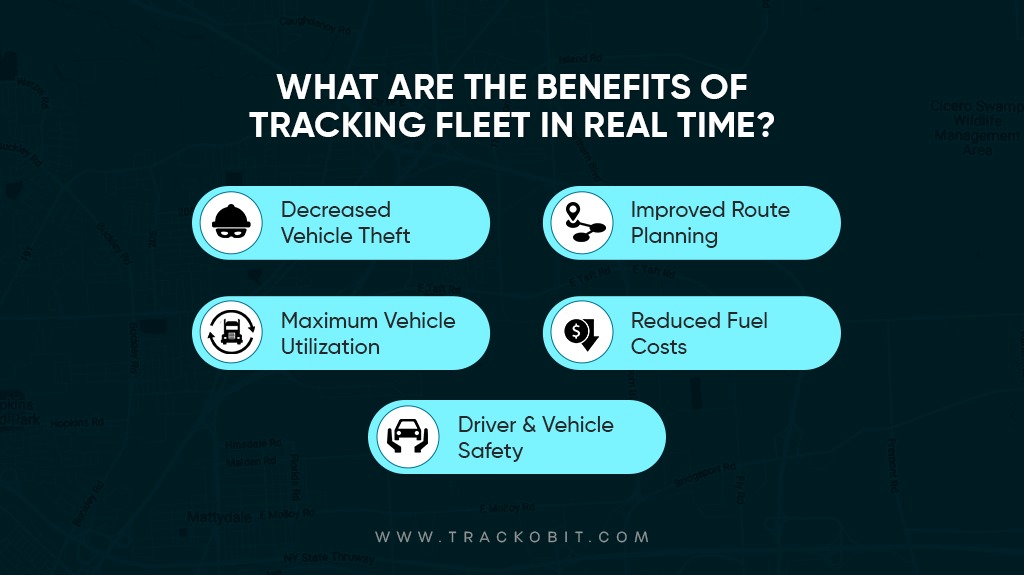
Benefits of Tracking a Fleet in Real Time
c) Maximum Vehicle Utilisation
Real time tracking provides instant updates on vehicle location and utilisation. Fleet managers are getting insights into fleet operations. They get a clear picture of the vehicles working overtime or being underutilised. With the help of tracking and management solutions, they can redistribute vehicles to areas and routes where the demand is low or high accordingly.
This optimisation of the allocation of resources helps to ensure the utilisation of vehicles to maximum capacity.
Vehicle trackers identify idle or parked vehicles for an extended time, enabling fleet managers to take necessary actions to put the vehicles back in action or consider downsizing the fleet if required.
d) Reduced Fuel Costs
Fuel cost is one of the largest expenses for transportation and logistics companies. With real time tracking, managers know where and when their vehicles are being used. Overspeeding and poor driver behaviour negatively impact fuel efficiency, thus increasing costs.
But fuel monitoring solutions of fleet tracking software provide graphs and data on fuel consumption to detect abnormal fuel usage. Also, the software helps formulate the most efficient route for the vehicles that further reduces fuel consumption. Real time tracking plays a huge role in this as it tracks and ensures that the optimised route is followed.
e) Driver and Vehicle Safety
Well-maintained vehicles greatly impact the safety of the vehicles and drivers. The data recorded through tracking devices can very well be interpreted to detect deteriorating vehicle health. Furthermore, driver behaviour monitoring identifies reckless driver practices.
Fleet management software helps create maintenance schedules with automatic alerting based on odometer readings. Many GPS trackers have built-in accelerometers and alert drivers and managers to the pattern of poor driving behaviours such as harsh braking, acceleration and harsh cornering. AI enable dashcams to provide managers with visual visibility into distracted driving, tailgating and red light jumping.
Conclusion
With the new technology coming in daily, they simplify and enhance fleet management. Fleet-dependent companies enjoy multiple benefits such as enhanced visibility, cost savings, improved safety, and better compliance, all thanks to real-time vehicle tracking. The combination of real time tracking and fleet management solutions is truly amazing.
TrakoBit is one such fleet management solution with numerous accolades associated with it. It has some of the most sought-after solutions, such as video telematics, fuel monitoring, and driver behaviour monitoring, to name a few.
Frequently Asked Questions
-
What technologies are used in real-time tracking?
It typically involves - GPS, cellular networks, - IoT sensors, - cloud-based software, - and AI-driven analytics.
-
How accurate is real-time GPS tracking for vehicles?
GPS tracking can be accurate within a few meters. This depends on signal strength, weather conditions, and satellite availability.
Tithi Agarwal is an established content marketing specialist with years of experience in Telematics and the SaaS domain. With a strong background in literature and industrial expertise in technical wr... Read More
Related Blogs
-
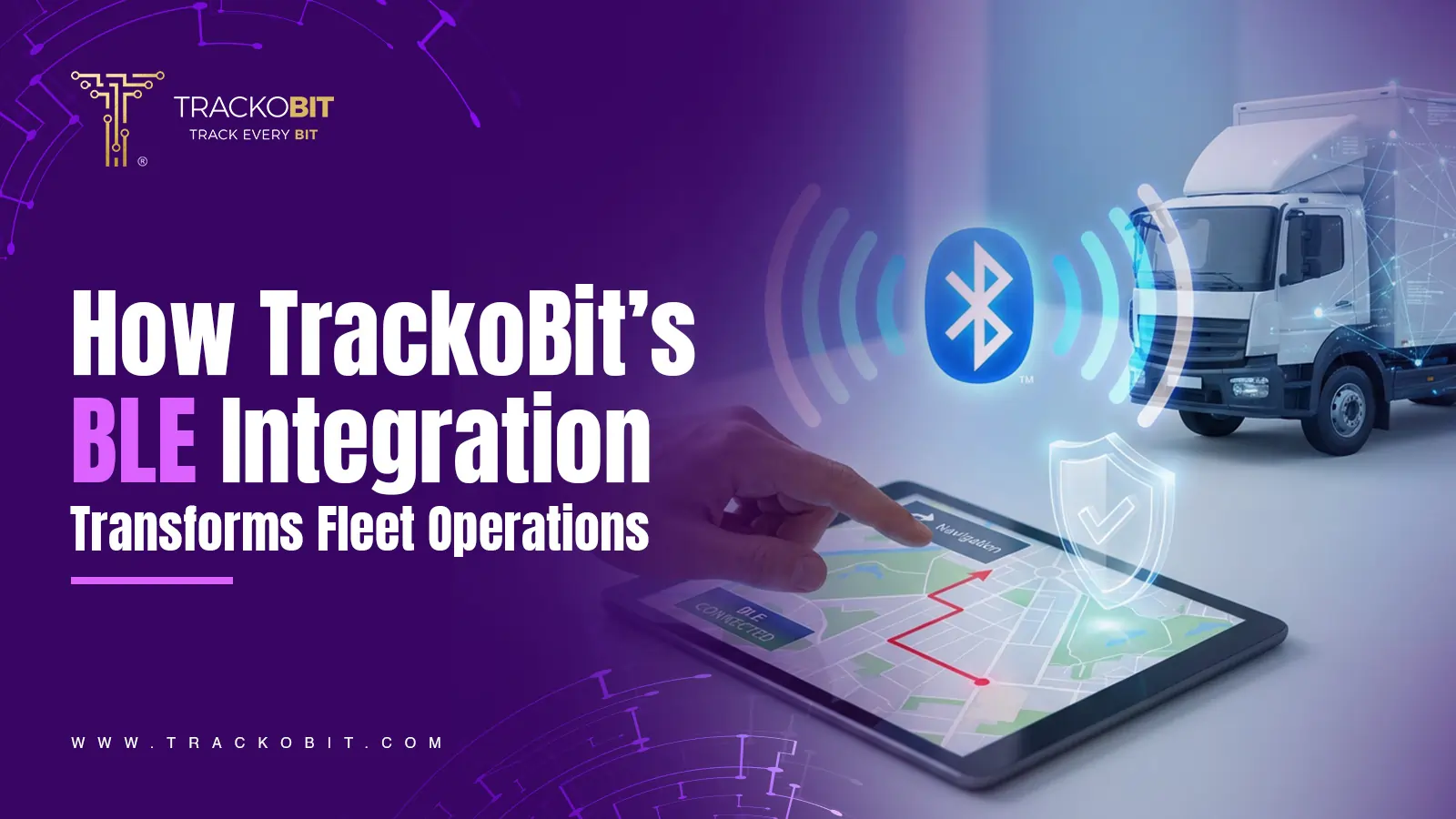
Plug, Pair, Perform TrackoBit Introduces BLE Sensor Integration
Tithi Agarwal November 26, 2025TrackoBit’s BLE Sensor Integration enables wireless, real-time monitoring with faster installs and accurate insights. It improves fleet efficiency, visibility, and…
-
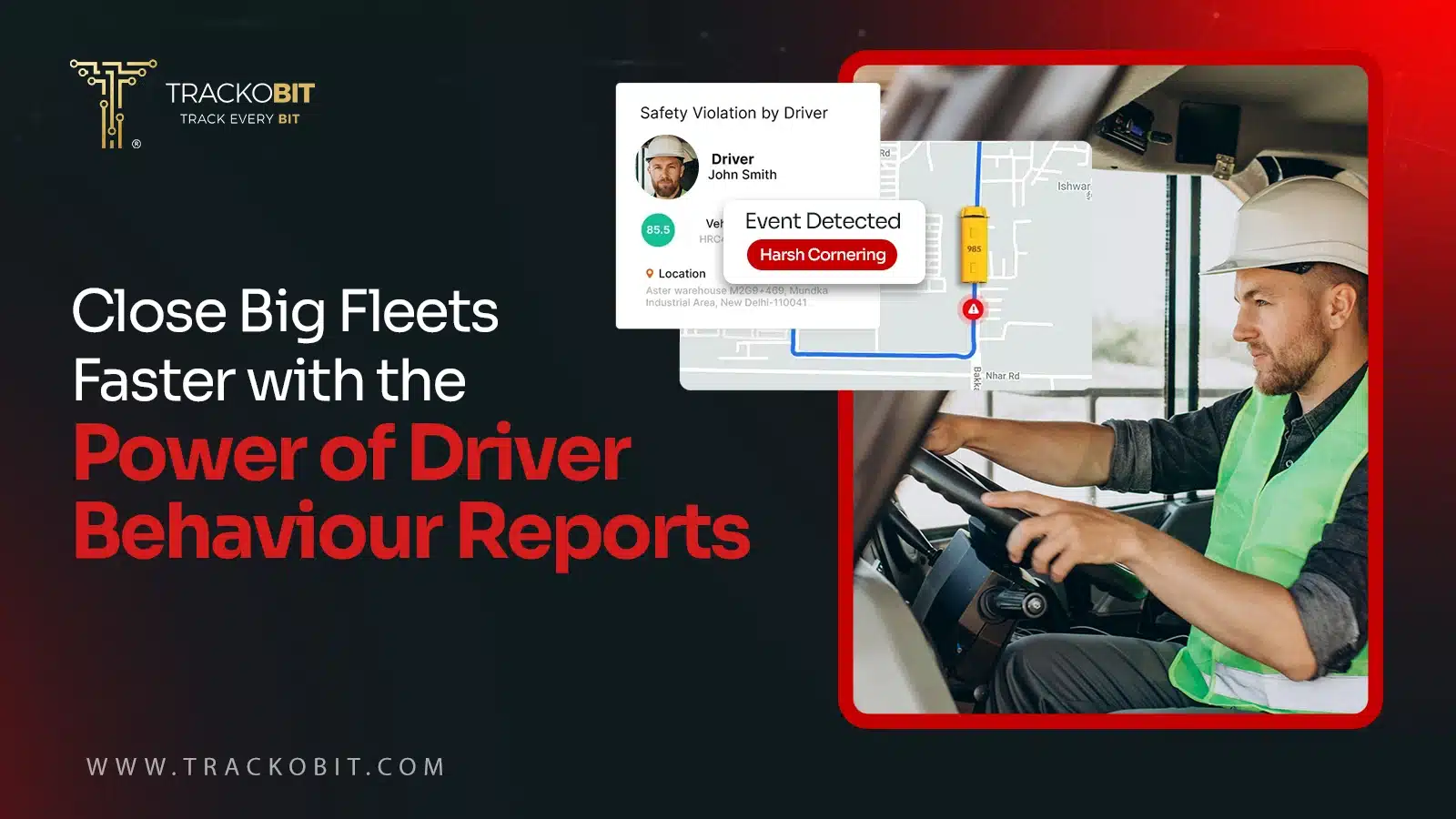
How to Use Driver Behavior Reports as a Sales Hook to Close Big Fleets
Tithi Agarwal October 16, 2025TrackoBit’s driver behavior reports empower fleet providers to win big contracts by showcasing safety, efficiency, and measurable ROI.
-
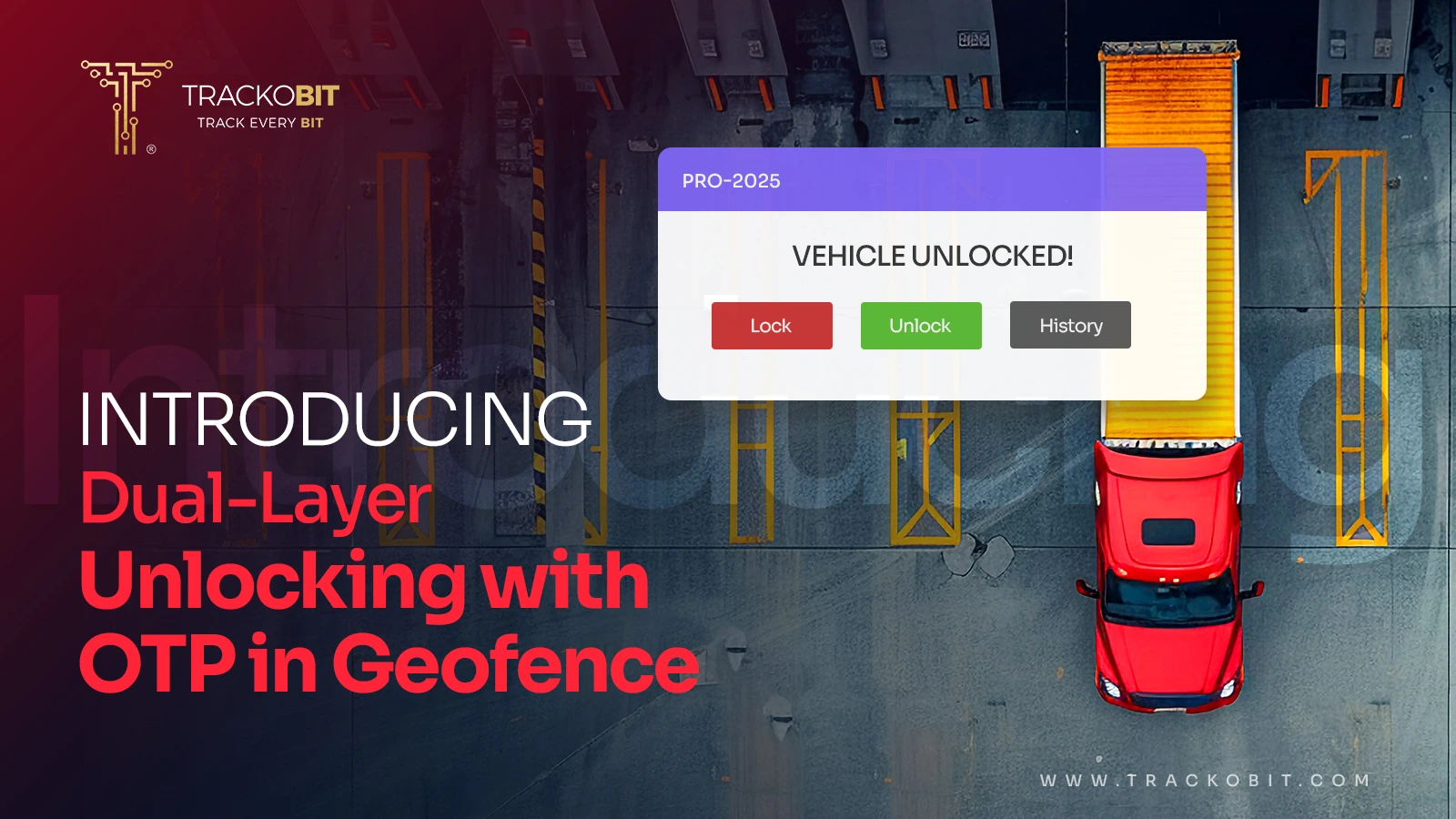
TrackoBit’s Unlocking in Geofence with OTP: Elevating Cargo Protection
Tithi Agarwal September 16, 2025TrackoBit’s latest feature – Unlocking in Geofence with OTP lets you lock out theft and unlock cargo only at the…
-
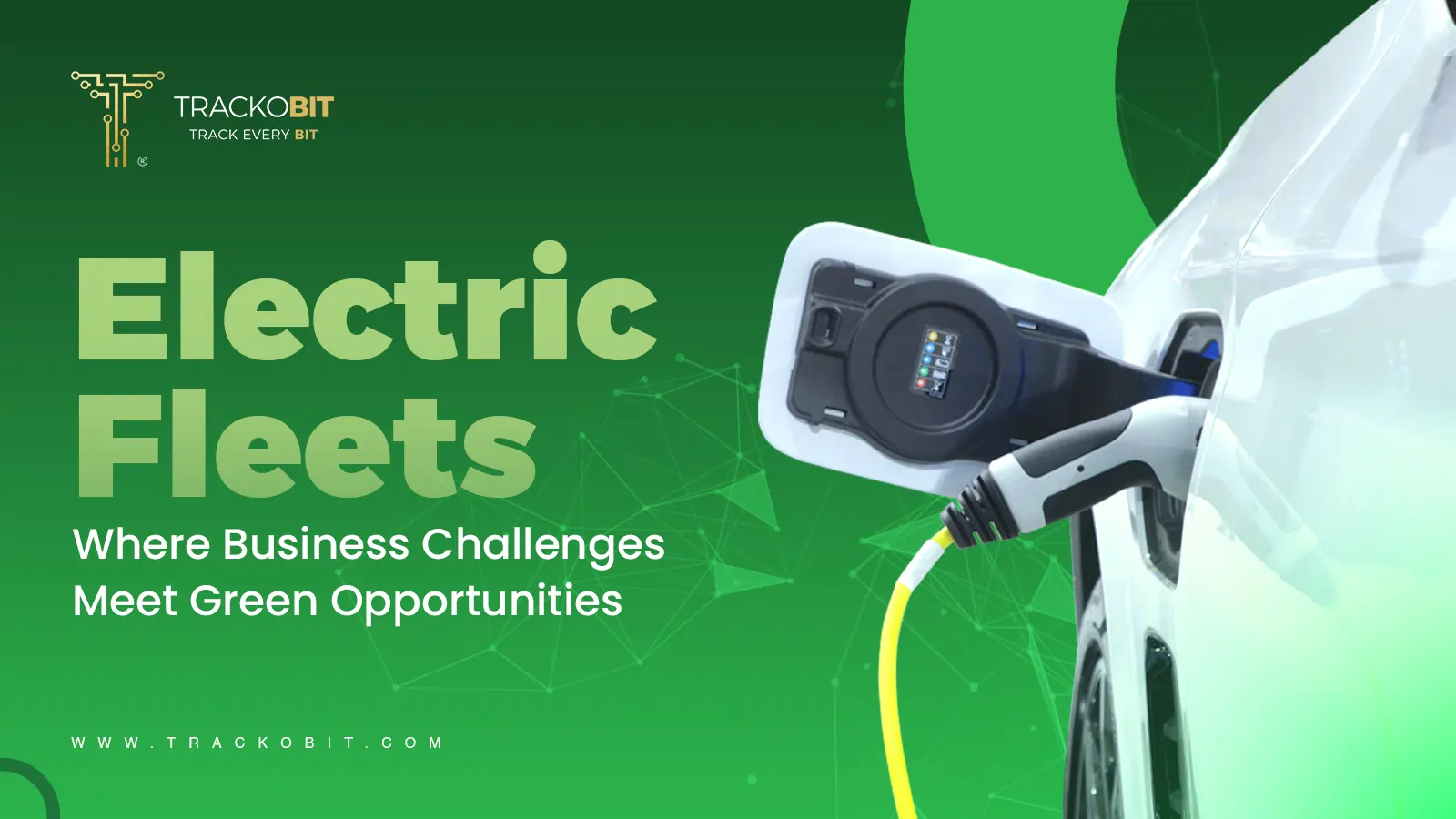
The Rise of Electric Fleets: Challenges and Opportunities for Businesses
Tithi Agarwal September 4, 2025The global fleet landscape is poised for a decade-long transformation. This change is being powered by electricity. Logistics-led businesses are…

Subscribe for weekly tips to optimize your fleet’s potential!
Your inbox awaits a welcome email. Stay tuned for the latest blog updates & expert insights.
"While you're here, dive into some more reads or grab quick bites from our social platforms!"Stay Updated on tech, telematics and mobility. Don't miss out on the latest in the industry.
We use cookies to enhance and personalize your browsing experience. By continuing to use our website, you agree to our Privacy Policy.
































